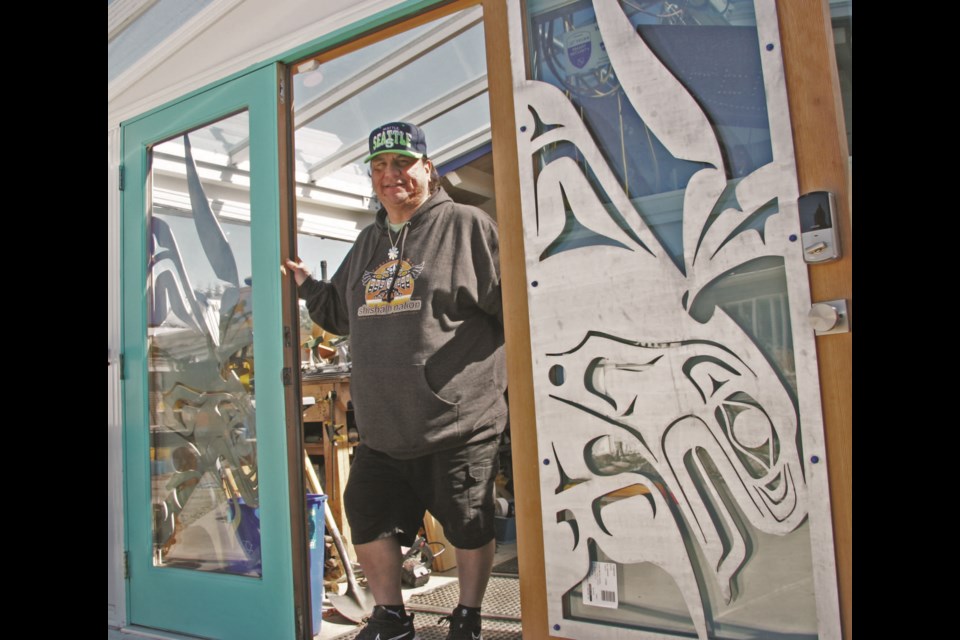This article is from the summer 2024 edition of Coast Life magazine.
An enticing aroma of cedar permeates the air as carver Derek Georgeson enters his gallery workspace in ch’atlich (Sechelt). Past the double doors bearing a metal blackfish design, which he created digitally and had fabricated elsewhere, he holds up his latest work-in-progress: a red cedar wall panel with a stylized eagle facing a bear.
These and his other carved figures include traditional Coast Salish/Homalco ovoid designs, which Derek says took him roughly a decade to figure out, along with the stories behind them.
Derek’s paternal relations are from Xwémalhkwu Homalco First Nation in Wei Wai Kum (Campbell River, B.C.) and his maternal ones from Witset (Moricetown) near the traditional territory of the Gidimt’en and Wet’suwet’en people (Smithers).
One of his first carvings was a stunning red cedar raven mask, bearing long cedar strips and a mouth that clacks when you pull a string. Derek took it to gatherings and protests, such as the Idle No More rally in ch’atlich in January 2013 and a Truth and Reconciliation Day walk in Musqueam/Squamish/Tsleil-Waututh territories (Vancouver).
He says he lets the wood show him what to carve. “I just go ahead and do it. It’s my art and nobody can say, ‘You did that wrong.’ I’ve always been told there’s no mistake in carving.”
One of his biggest fans, says Derek, was the late carver Beau Dick, a Kwakwaka’wakw artist and chief from Yalis (Alert Bay, B.C.), whose “mindblowing” masks can be scary, in Derek’s view. In contrast, he comments: “Every mask I make comes with a smile.” Today, he calls his raven mask “retired,” in the home of a collector in S’ólh Téméxw (Abbotsford). Born and raised in Vancouver, Derek says he watched Kwakiutl street carvers Richard and Alex Mountain at work in the city. Later, after moving to Wei Wai Kum, he observed his Uncle Mannie carving.
Derek began his own works in 2006, mentored by his Homalco cousins Darren and Bill Blaney and inspired by his grandfather Albert, a canoe carver, and his father Ralph, who carved.
After a move to the Sunshine Coast, he watched the late master carver ?antuni Tony Paul of the shíshálh Nation work on creations such as the reconciliation totem pole.
Derek has hand-carved four totem poles: two remain on the Sunshine Coast, one in S’ólh Téméxw and one in Wei Wai Kum. A striking red cedar pole featuring a bear with a salmon formed the visual centrepiece of his artist stall at a Hackett Park craft fair. Only two hours after Derek displayed it, an avid admirer said, “I have to have it,” he recalls. The pole now stands outside a residence at Francis Peninsula in kálpílín (Pender Harbour), looking out to sea. His other local pole, of a bear and salmon, adorns the government dock in xwilkway (Halfmoon Bay).
Besides hand-carving cedar creations with an adze, Derek has wielded a chainsaw to create a totem pole of a bear and eagle, which is now with the Tla’amin First Nation in qathet (Powell River).
He says he has gleaned chainsaw carving tips and techniques from CTV’s reality series A Cut Above. Shot in Skwxwú7mesh (Squamish, B.C.), the show features a dozen of the world’s top chainsaw carvers vying to win challenges.
Beyond poles and masks, Derek also carves desks, benches and tabletops, including a four-by-eight-foot table of a wolf and eagle now in a home in Delta on the unceded territories of the scəw̓aθən (Tsawwassen), xʷməθkʷəy̓əm (Musqueam), and other Coast Salish peoples. All the wood he uses is local, including some old-growth yellow cedar from which he carved a tall raven feather. “It was like cutting butter,” he says. “Every cut made me happy.” At Orford Bay
near Wei Wai Kum, his carved welcome sign, featuring three grizzlies, promotes tours on Bute Inlet.
Recently, Derek and his cedar-weaver wife Shyanne (“Shy”) Watters were commissioned by the Sunshine Coast Arts Centre, in partnership with the Sechelt Downtown Business Association, to create three Coast-Salish-based sea creature designs. (The couple had a 2019 exhibition Texem-ay (Red Cedar), with Levi Darrow Purjue, at the Centre.) The art will be part of “wayfinding” or a visual path, with seating, between downtown ch’atlich and the Centre.
Derek has been asked to carve another pole for Wei Wai Kum, but this work has been delayed. Following recent surgery, he’s been told not to carve for six months. In the meantime, he says he’s doodling on paper, trying to better understand his iPad and figure out how to make a traditional bentwood box. This summer, Derek will appear alongside Shy on Coastal Carvings, a documentary series on the Aboriginal Peoples Television Network. He and Shy are part of the Sunshine Coast artists’ Purple Banner Tour.
The two artists, who have a blended family of four adult children and two grandchildren, met in July 2011 on the Salish Sea just off Francis Peninsula during an annual tribal canoe journey. Derek says: “I asked her, ‘What’s your name? Where are you from?’ That was the end.” With a chuckle, he adds, “…or the beginning.”


.jpg;w=120;h=80;mode=crop)
